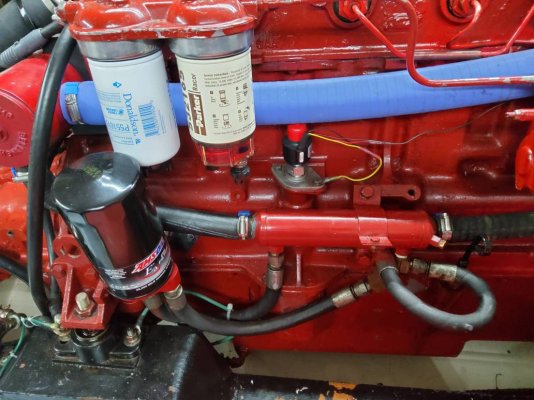R. Bush
Veteran Member
I decided to see if I could find the missing fin from my impeller that I noticed was AOL when I put the boat up for the winter. My raw water pump is connected to the engine oil cooler by two short lengths of hose with an aluminum(?) tube in the middle. Mine had obviously been there for a while, and I eventually resorted to a heat gun and slip lock plyers to loosen the hoses enough on the tube that I could get the assembly apart (destroying the hoses in the process). This seems to be a pretty common setup on Leman engines and I was wondering if other people have difficulty getting the setup apart to hunt down impeller bits and pieces?
I was thinking it might make sense to simply ditch the solid tube and put one continuous piece of hose between the raw water pump and the cooler. The way I see it that would make it easier to bend and flex the hose to remove it when needed. Does anyone know a reason not to do this. It would also have the advantage of reducing the number of hose connections from four down to two.
I have seen some people suggest putting a "Y" strainer in this section of hose to catch impeller bits before they get to the oil cooler. Is there any reason not to add a strainer to the system?
My impeller chunk was sitting right there waiting for me to retrieve it. Looking into the cooler is seems that it would be pretty hard for any bits to make it any further into the system. Am I right in that thought?
Looking forward to hearing what the engine gurus have to say!
I was thinking it might make sense to simply ditch the solid tube and put one continuous piece of hose between the raw water pump and the cooler. The way I see it that would make it easier to bend and flex the hose to remove it when needed. Does anyone know a reason not to do this. It would also have the advantage of reducing the number of hose connections from four down to two.
I have seen some people suggest putting a "Y" strainer in this section of hose to catch impeller bits before they get to the oil cooler. Is there any reason not to add a strainer to the system?
My impeller chunk was sitting right there waiting for me to retrieve it. Looking into the cooler is seems that it would be pretty hard for any bits to make it any further into the system. Am I right in that thought?
Looking forward to hearing what the engine gurus have to say!

